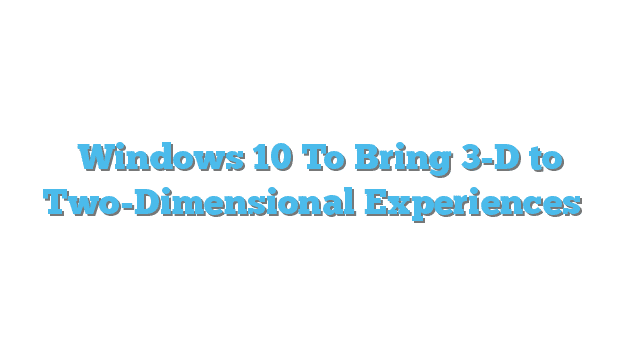The new tools, part of a free “Creators Update” to Windows 10 early next year, promise to make it easy for people to create and share photos, drawing and other images in 3-D.
Instead of taking a regular photo of a sand castle in two dimensions, for instance, a beach-goer can scan all sides of the castle with a phone. Microsoft’s tools will convert that into 3-D; viewers can rotate the virtual sand castle on the screen with their fingers. Microsoft plans to make it easy to share that on social media and even send to 3-D printers.
Business presentations can be enhanced as 3-D support comes to PowerPoint; you can rotate an object to focus on a particular angle. Microsoft’s image-editing software Paint will also enable people to create 3-D artworks by combining existing 2-D images with newly scanned objects in three dimensions.
“By making 3-D for everyone, our digital world starts a new, more human journey,” said Megan Saunders, a Microsoft executive in charge of transitioning computing to three dimensions.
Microsoft also announced a high-end desktop called Surface Studio. Costing about $3,000, the Studio will be targeted at creators such as architects, artists and engineers, many of whom have long used Apple’s Mac computers. The 28-inch display is on a flexible hinge, so users can view it straight on, or tilt it to as low as 20 degrees for drafting. Microsoft also announced Surface Dial, a circular accessory with new ways to scroll and navigate.
Wednesday’s announcements come a day before Apple is expected to refresh its Mac lineup.
Microsoft’s Surface sales aren’t high enough to rank on either Gartner’s or IDC’s list of top five personal-computer manufacturers, but they represent an important business for the software company as it showcases the virtues of Windows 10 and related services such as Bing search and Skype chats.
The Surface Studio will likely be a niche product, with the Surface Pro 4 tablet still available for everyday consumers starting at about $900. Yet Studio represents Microsoft’s vision for the future of computing.
Satya Nadella, Microsoft’s CEO, said innovations over the past decade have been focused on consumption, “helping us consume more information and media in different formats.” While that is important, he said, the next decade will be defined by technology that empowers people to create.
Microsoft, maker of the Xbox gaming console, is also targeting gamers. The upcoming Windows 10 update will have new features for live broadcasting game play.
Another Windows feature promises help people communicate more easily with friends and family. Windows will try to make multiple apps for video calls, email and texts seamless by letting users simply choose the person to send to rather than the app to send with. Text support will likely require a Windows or Android phone, though; iPhone support wasn’t promised.
© 2016 Associated Press
syndicated under contract with NewsEdge. -.







